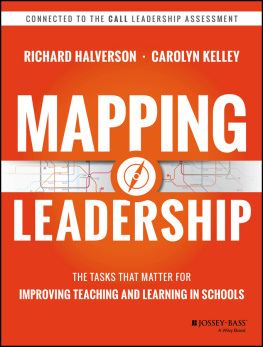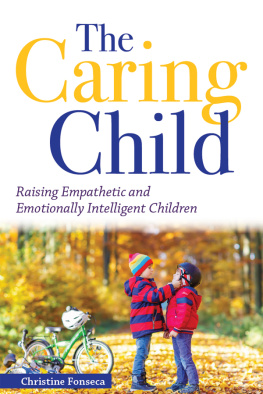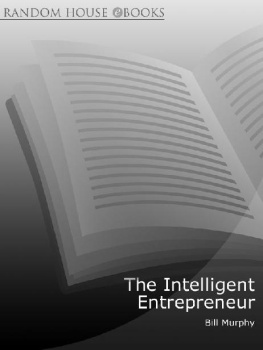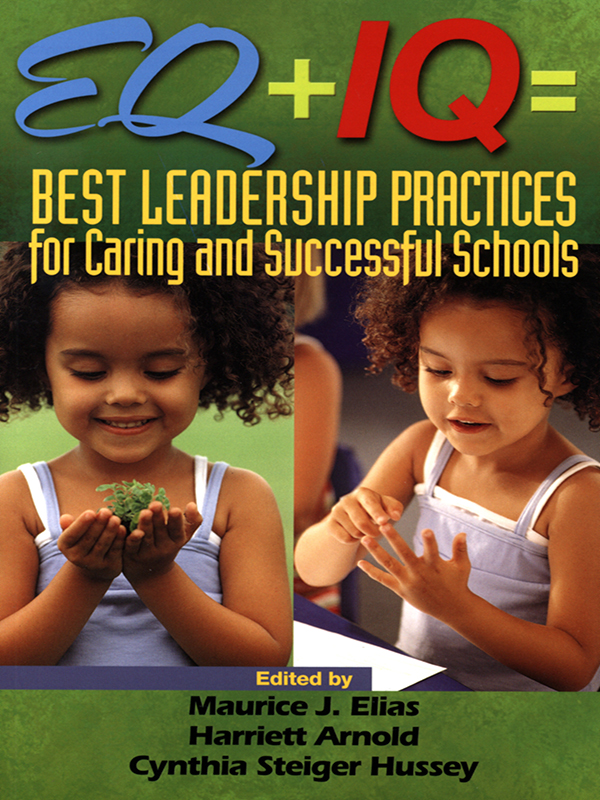We would like to dedicate this book to James Comer, whose inspiration, dedication, generosity, persistence, and unflagging belief in the potential of every youngster regardless of degree of risk or disadvantage continue to be catalysts and models for those in the field who care deeply about children.
He is the embodiment of EQ + IQ.
Copyright 2003 by Corwin Press, Inc.
All rights reserved. When forms and sample documents are included, their use is authorized only by educators, local school sites, and/or noncommercial entities who have purchased the book. Except for that usage, no part of this book may be reproduced or utilized in any form or by any means, electronic or mechanical, including photocopying, recording, or by any information storage and retrieval system, without permission in writing from the publisher.

For information:

Corwin Press, Inc.
A Sage Publications Company
2455 Teller Road
Thousand Oaks, California 91320
www.corwinpress.com
Sage Publications Ltd.
6 Bonhill Street
London EC2A 4PU
United Kingdom
Sage Publications India Pvt. Ltd.
B-42 Panchsheel Enclave
New Delhi 110 017 India
Printed in the United States of America
Library of Congress Cataloging-in-Publication Data
EQ + IQ = Best leadership practices for caring and successful schools / edited by Maurice J. Elias, Harriett Arnold, and Cynthia Steiger Hussey.
p. cm.
Includes bibliographical references and index.
ISBN 0-7619-4520-2 (cloth)
ISBN 0-7619-4521-0 (paper)
1. Educational leadership-United States. 2. School improvement programs-United States. 3. Emotional intelligence. I. Title: EQ and IQ. II. Title: EQ plus IQ. III. Elias, Maurice J. IV. Arnold, Harriett. V.
Hussey, Cynthia Steiger.
LB2805 .E69 2003
371.2dc21
2002014620
This book is printed on acid-free paper.
02 03 04 05 10 9 8 7 6 5 4 3 2 1

| Acquisitions Editor: | Faye Zucker |
| Editorial Assistant: | Julia Parnell |
| Copy Editor: | Elizabeth Budd |
| Production Editor: | Denise Santoyo |
| Typesetter: | C&M Digitals (P) Ltd |
| Indexer: | Molly Hall |
| Cover Designer: | Tracy E. Miller |
| Production Artist: | Michelle Lee |
T he events of September 11, 2001, have made the already-challenging mission of schools even more so, demanding that we prepare children for the tests of life and not merely a life of tests (Elias, 2001). School leaders must find ways for students to emerge from their education experiences knowledgeable, responsible, nonviolent, drug-free, and caring, as well as imbued with the social and emotional skills needed to deal with the opportunities and risks that life presents in abundance.
But even before September 11, there was growing recognition that the definition of what it means to be well educated must expand if students are to be prepared for adult roles in the 21st century. Daniel Golemans book Emotional Intelligence (Goleman, 1995) was the lightning rod for this recognitionnot only in the United States but in countries speaking the 30 languages into which the book was translated. EQ, as emotional intelligence has come to be known, has a rightful place alongside IQ in conceptualizing what it means to be smart. In fact, extensive research since 1995 has shown that EQ is an essential part of success in academics, in the workplace, and in civic and family life. Like IQ, the role of EQ might best be described as necessary but not sufficient. IQ + EQ, however, seems to be an unbeatable combination.
Brain research supports the movement toward integration of IQ and EQ in education. Educators already realize this from the acceptance in schools of many of the tenets of multiple intelligences theory and practice. Emotional intelligence is strongly linked to Howard Gardners interpersonal and intrapersonal intelligences, as well as to his emerging area of spiritual intelligence. The recent work of LeDoux and Damasio, Caine and Caine, Wolfe, Jensen, Sylwester, and othersstriving to understand how instruction can be more brain friendly consistently points in the direction of the social and relational base of lasting, deep, and meaningful learning. More to the point, climate counts for a great deal; indeed, the wisdom of the character education movement was in recognizing that children cannot learnand teachers cannot teachin toxic environments beset by strong negative emotions such as fear, hatred, anger, resentment, disillusionment, and hopelessness. Yet it would be dishonest to say that these negative emotions are unknown in schools, or at least in significant segments of school populations.
The point must be made that there is a synergistic, perhaps even symbiotic, relationship between school staff and student morale and character. The educational mantra of the early 21st century, No child shall be left behind, reflects a truth that schools are not equally effective for all students. But even as educators are still figuring out the challenges of educating all groups of students, schools still can be places in which students feel accepted, cared about, safe, and valued. As this book proves, we already know a great deal about how to create a high EQ school. Many examples of high EQ schools exist, and their description is the main point of this book.
WHO SHOULD READ THIS BOOK AND WHY
This book is addressed to those who are concerned about building schools as communities. It is intended to show educators how to meet academic standards and how to have schools that are safe and that prepare students to understand the foundation of our system of democracy and participate in its workings. This book is for those who want their schools to change and to be different and better.
Those who learn through case examples can also use this book. It is based on examples from practice that are excellent but also attainable. These schools are not one-time-only projects, but enduring efforts. This book should therefore be of particular interest to educational administrators, curriculum coordinators, superintendents, school board members, parents, and those in college and university programs whose mission includes the preparation of educational leaders.
Also included in the audience for this book are the many professionals whose jobs relate to the climate and character of the schools. These are school psychologists, professional school counselors, substance abuse coordinators, health educators, disciplinarians, studentfamily support personnel, and other school consultants.
The design of the book is meant to inspire those in a position to influence schoolwide change to make the necessary efforts. It is not a how-to-do-it manual because that is not what our readers need at this point. Many people seem to be poised on the sidelines of school change, waiting for a push to get into the game. Sometimes crises of school violence and substance abuse provide the necessary push, but crisis as the catalyst for systematic school-wide change works against long-term success.













